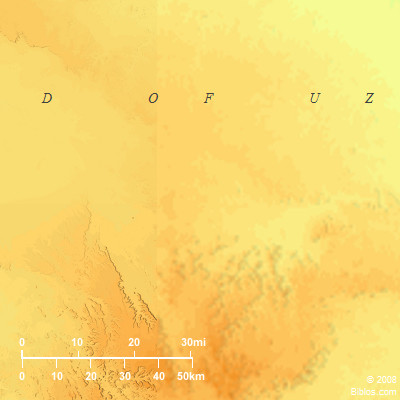Atlas  Uz and surrounding area Maps Created using Biblemapper 3.0 Additional data from OpenBible.info You are free to use up to 50 Biblos coprighted maps (small or large) for your website or presentation. Please credit Biblos.com. Occurrences Job 1:1 There was a man in the land of Uz, whose name was Job. That man was blameless and upright, and one who feared God, and turned away from evil.Job 9:13 "God will not withdraw his anger. The helpers of Rahab stoop under him. Job 26:12 He stirs up the sea with his power, and by his understanding he strikes through Rahab. Jeremiah 25:20 and all the mixed people, and all the kings of the land of the Uz, and all the kings of the Philistines, and Ashkelon, and Gaza, and Ekron, and the remnant of Ashdod; Lamentations 4:21 Rejoice and be glad, daughter of Edom, that dwell in the land of Uz: The cup shall pass through to you also; you shall be drunken, and shall make yourself naked. Encyclopedia UZ (2)('uts; Septuagint Ausitis; Vulgate (Jerome's Latin Bible, 390-405 A.D.) Ausitis): The home of the patriarch Job (Job 1:1 Jeremiah 25:20, "all the kings of the land of Uz"; La 4:21, "daughter of Edom, that dwellest in the land of Uz"). The land of Uz was, no doubt, the pasturing-ground inhabited by one of the tribes of that name, if indeed there be more than one tribe intended. The following are the determining data occurring in the Book of Job. The country was subject to raids by Chaldeans and Sabeans (1:15, 17); Job's three friends were a Temanite, a Naamathite and a Shuhite (2:11); Elihu was a Buzite (32:2); and Job himself is called one of the children of the East (Qedhem). The Chaldeans (kasdim, descendants of Chesed, son of Nahor, Genesis 22:22) inhabited Mesopotamia; a branch of the Sabeans also appears to have taken up its abode in Northern Arabia (see SHEBA). Teman (Genesis 36:11) is often synonymous with Edom. The meaning of the designation amathite is unknown, but Shuah was a son of Keturah the wife of Abraham (Genesis 25:2), and so connected with Nahor. Shuah is identified with Suhu, mentioned by Tiglath-pileser I as lying one day's journey from Carchemish; and a "land of Uzza" is named by Shalmaneser II as being in the same neighborhood. Buz is a brother of Uz ("Huz," Genesis 22:21) and son of Nahor. Esar-haddon, in an expedition toward the West, passed through Bazu and Hazu, no doubt the same tribes. Abraham sent his children, other than Isaac (so including Shuah), "eastward to the land of Qedhem" (Genesis 25:6). These factors point to the land of Uz as lying somewhere to the Northeast of Palestine. Tradition supports such a site. Josephus says "Uz founded Trachonitis and Damascus" (Ant., I, vi, 4). Arabian tradition places the scene of Job s sufferings in the Hauran at Deir Eiyub (Job's monastery) near Nawa. There is a spring there, which. he made to flow by striking the rock with his foot (Koran 38 41), and his tomb. The passage in the Koran is, however, also made to refer to Job's Well. Strong's Hebrew H5780: Utsa son of Aram, also a son of Nahor, also an Edomite, also perhaps a district East of Pal. |



